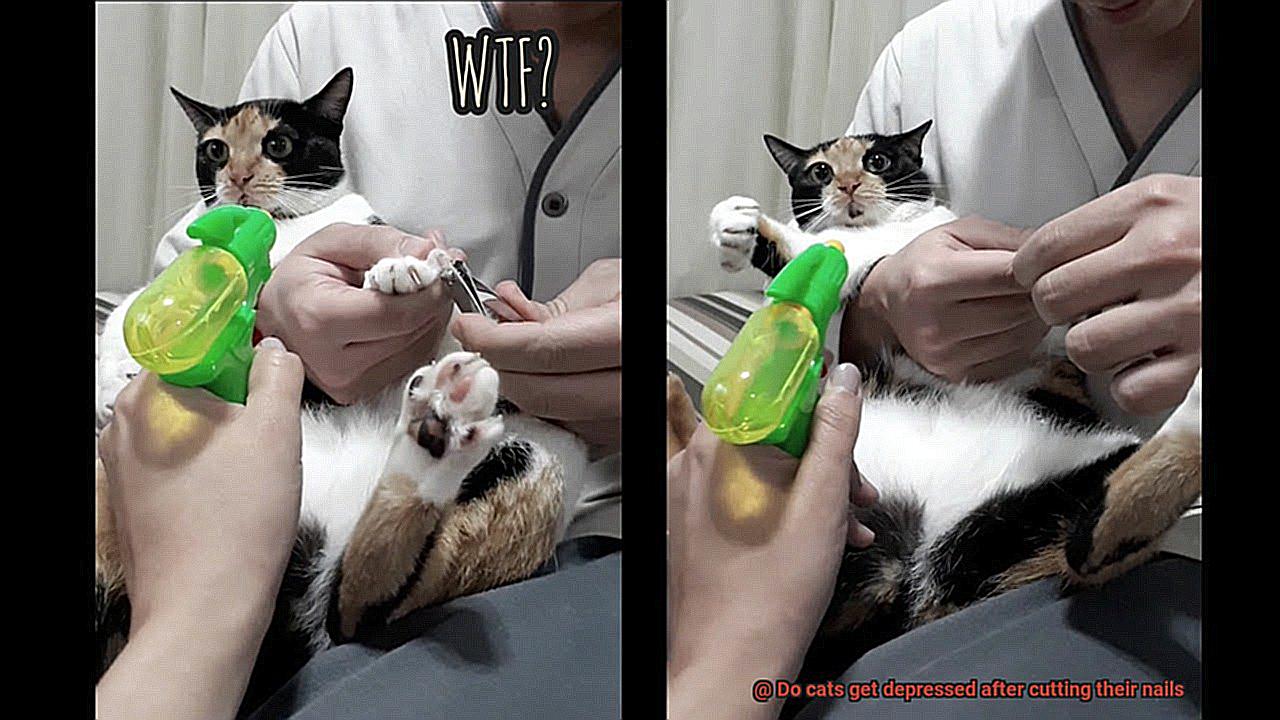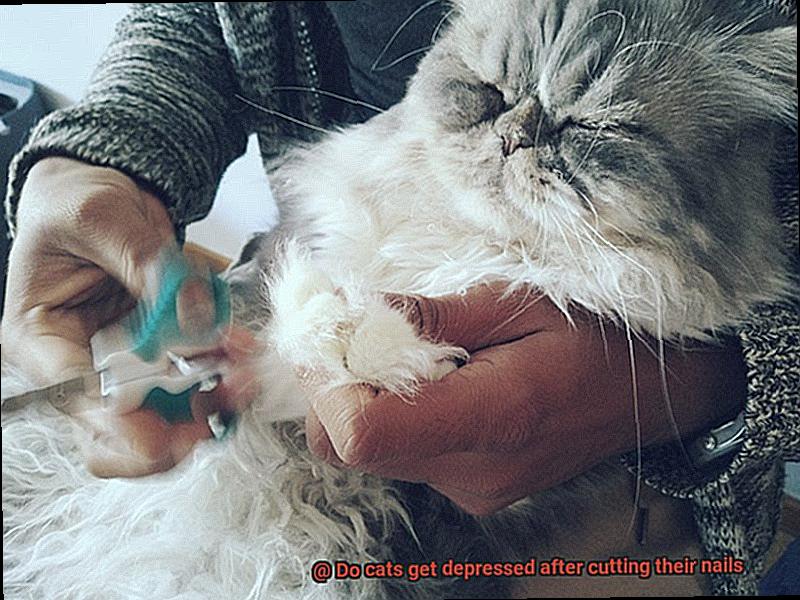Have you ever noticed a sudden change in your cat’s demeanor after a nail trimming session? Your once playful and affectionate feline friend may seem distant and detached, leaving you wondering if they’re experiencing post-nail-trimming depression. As an expert in the field of cat behavior, I’ve come across this question time and time again, prompting me to conduct thorough research and observations on the matter.
It’s important to note that cats have feelings just like humans do. They can experience different emotions, including stress and discomfort during the nail trimming process. Additionally, their claws play a crucial role in their well-being as they use them for climbing, scratching, hunting, and self-defense. Cutting their nails can affect these natural instincts and cause anxiety.
So, do cats get depressed after cutting their nails? The answer isn’t as simple as yes or no. There are various factors at play that we need to explore further to fully understand the situation. In this blog post, we’ll delve into the reasons behind your cat’s altered behavior following a nail trim, the significance of claws in their lives, and how to make the process comfortable for them.
Are you ready to unravel this intriguing topic with me? Let’s dive in together.
What are the Benefits of Trimming Your Cat’s Nails?
One crucial aspect of your cat’s grooming routine is trimming their nails. While it may seem like a daunting task, it is actually an essential part of their care that provides numerous benefits.
Firstly, trimming your cat’s nails can prevent painful ingrown nails. When a cat’s claws become too long, they can curl under and grow into the paw pad, leading to discomfort and even infection. Regular nail trims can prevent this from happening and save your kitty from unnecessary pain.
In addition to preventing ingrown nails, trimming your cat’s nails can also help with their balance and mobility. As cats age, overgrown claws can make it difficult for them to walk and climb. Keeping their nails short and neat can help them maintain their agility and prevent falls or injuries.
But that’s not all – trimming your cat’s nails can also improve their behavior. Cats with long claws may be more likely to scratch at furniture or people, but regular nail trims can reduce the urge to scratch inappropriately. Not only that, but trimmed nails make it easier for you to handle and pet your cat without worrying about accidental scratches.
While some cats may experience discomfort or stress during the nail trimming process, it usually doesn’t last long and won’t result in long-term depression. As a responsible cat owner, it is important to use proper techniques and tools when trimming their nails to ensure that the process is as painless as possible.
Is It Possible for Cats to Get Depressed After Cutting Their Nails?
It’s natural to wonder if cats can become depressed after a nail clipping session. While there is no definitive answer, it’s important to consider the emotions of cats and how they react to different situations.

Cats are emotional beings and can experience stress and anxiety. However, whether or not they feel depressed after nail trimming is still up for debate. One possible explanation for cats feeling sad or anxious after nail trimming is because the experience can be stressful for them.
Cats are sensitive to changes in their surroundings, and sudden movements or noises can be overwhelming for them. Additionally, some cats may feel discomfort or pain during the nail clipping process, which could contribute to feelings of depression.
Despite this, many pet owners report no signs of depression in their cats after a nail trimming session. In fact, some cats seem to relish the attention and grooming that comes with nail clipping. Every cat is unique and will react differently to different situations.
So, can cats get depressed after cutting their nails? While it’s possible for cats to feel sad or anxious after a nail trimming session, there is no definitive evidence suggesting that they will experience depression. Most cats should be able to handle it without any negative emotional effects as long as it’s done gently and safely.
As a responsible cat owner, it’s crucial to use proper techniques and tools to ensure that the process is as painless as possible. Trimming your cat’s nails is an essential part of their grooming routine that can prevent painful ingrown nails, improve their balance and mobility, and even enhance their behavior.
How to Make the Nail Trimming Process as Stress-Free as Possible
However, the process can be stressful for both you and your cat, leaving them anxious or upset. But fear not. Here are five tips to make the nail trimming process as stress-free as possible.
Start Early:
The earlier you start getting your cat used to having their paws handled, the better. By gently touching and holding their paws while giving them treats or praise, you can help your cat become more comfortable with the process as they grow older.
Choose the Right Time and Place:
Finding a quiet and comfortable spot in your home where your cat feels safe and secure is crucial. It may also be helpful to wait until your cat is relaxed or sleepy before attempting to trim their nails.
Use High-Quality Nail Clippers:

Using sharp and high-quality clippers specifically designed for cats’ nails can make a big difference in reducing pain and discomfort during the trimming process. Dull or inappropriate clippers can cause pain, making the experience more stressful for your cat.
Create a Calming Environment:
Playing soothing music, using pheromone sprays or diffusers, or even just talking to your cat in a calm and reassuring tone can help them relax during the nail trimming process.

Seek Professional Help if Necessary:
If your cat is particularly anxious or resistant to having their nails trimmed, seeking the help of a professional groomer or veterinarian may be necessary. They can provide additional tips and techniques for making the process as stress-free as possible.
Signs That Your Cat May Be Experiencing Stress During the Nail Trimming Process
It’s important to recognize the signs of stress your cat may exhibit during this experience to make it more comfortable for both of you.
One of the most obvious signs of stress is vocalization. If your cat is meowing, hissing, or growling during nail trimming, it’s clear they’re uncomfortable. Some cats may even become aggressive towards their owner or the person trimming their nails.
Another sign of discomfort is physical resistance. If your cat is struggling, trying to pull away from you, flattening their ears against their head, or tucking their tail between their legs, it’s important to take notice and adjust your approach accordingly.
Excessive panting or salivating can also be a sign of extreme stress during nail trimming. This can be alarming for both you and your cat, so breaks and adjustments are necessary.
If you notice any of these signs during nail trimming, don’t worry. Breaking up the process into smaller sessions over time can help ease your cat’s anxiety. Additionally, using positive reinforcement techniques such as treats or toys can distract them and make the experience more positive.
Tips on How to Comfort a Cat After a Nail Trim
It’s not uncommon for cats to feel anxious or stressed after a nail trim. But fear not, I’m here to share some tips on how to comfort your cat post-nail trim.

Treats are a must
Offering your cat their favorite treat after the nail trim can help distract them from any discomfort they might be feeling. Positive reinforcement is always a win-win situation.
Playtime is key
Engage your cat in playtime with their favorite toys. This can help them release any pent-up energy and reduce stress. Plus, it’s always heartwarming to see your kitty having some fun.
Petting and praise
Gently petting your cat and offering words of encouragement can help them feel secure and loved. You want to show them that they’re not alone and that you’re there for them.
A quiet retreat
Provide your cat with a comfortable, quiet space to rest after the nail trim. This can help them relax and recover from any stress or anxiety they may have experienced during the process.
Familiar scents
Place a familiar blanket or toy near your cat to provide them with comforting scents that can help calm them down. It’s all about making them feel safe and at ease.
Conclusion
In conclusion, while cats may experience some discomfort and stress during the nail trimming process, there is no evidence to suggest that they will become depressed afterwards. As responsible cat owners, it’s crucial to use proper techniques and tools when trimming your cat’s nails to ensure a painless experience. Not only does regular nail trimming prevent painful ingrown nails, but it also improves your cat’s balance, mobility, and behavior.
To make the process as stress-free as possible for your furry friend, start early by getting them used to having their paws handled. Choose a quiet and comfortable spot in your home where they feel safe and secure. Use high-quality nail clippers specifically designed for cats’ nails, create a calming environment with soothing music or pheromone sprays, and seek professional help if necessary.
Recognizing the signs of stress during nail trimming is important. If you notice vocalization, physical resistance or excessive panting or salivating from your cat, don’t worry. Breaking up the process into smaller sessions over time can ease their anxiety.
After a successful nail trim session, comfort your cat with treats and playtime with their favorite toys. Give them gentle petting and praise while providing a quiet retreat with familiar scents.

